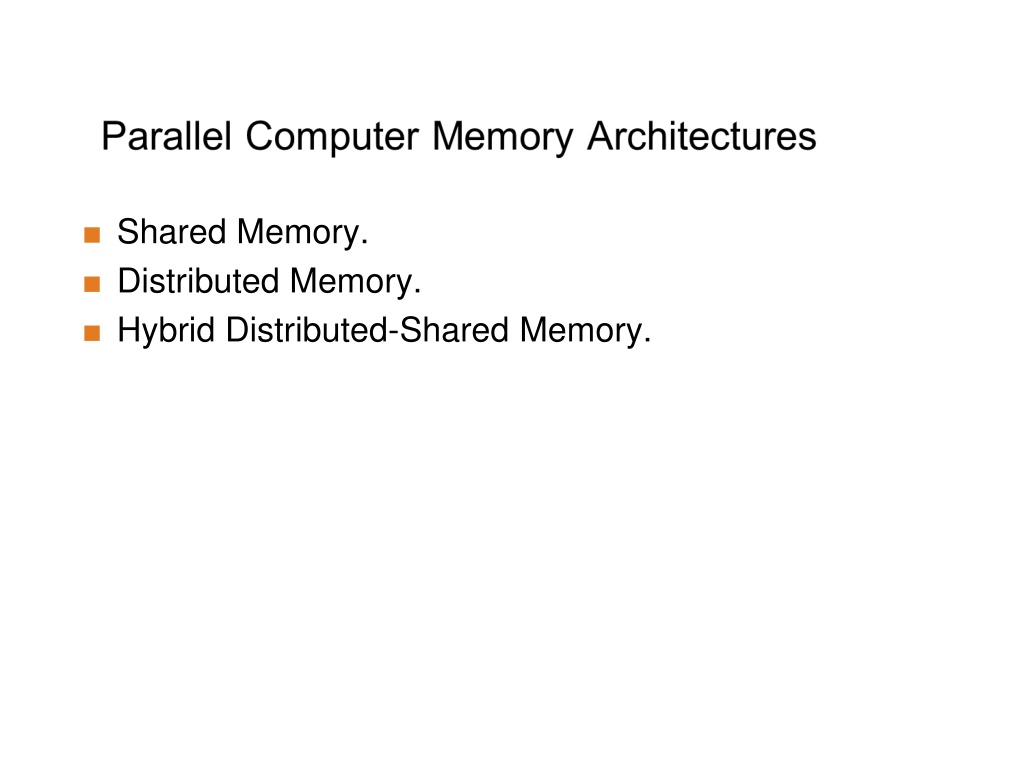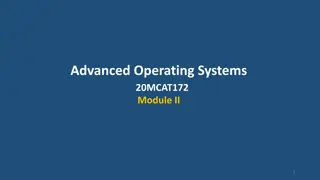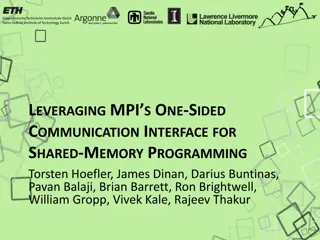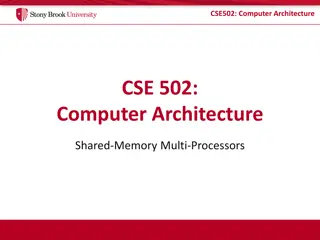Understanding Shared Memory, Distributed Memory, and Hybrid Distributed-Shared Memory
Shared memory systems allow multiple processors to access the same memory resources, with changes made by one processor visible to all others. This concept is categorized into Uniform Memory Access (UMA) and Non-Uniform Memory Access (NUMA) architectures. UMA provides equal access times to memory, while NUMA allows for varying memory access speeds among processors. The distinction between these architectures is crucial in designing parallel computing systems for optimal performance.
Download Presentation

Please find below an Image/Link to download the presentation.
The content on the website is provided AS IS for your information and personal use only. It may not be sold, licensed, or shared on other websites without obtaining consent from the author. Download presentation by click this link. If you encounter any issues during the download, it is possible that the publisher has removed the file from their server.
E N D
Presentation Transcript
Shared Memory. Distributed Memory. Hybrid Distributed-Shared Memory.
Shared Memory Shared memory parallel computers vary widely, but generally have in common the ability for all processors to access all memory as global address space. Multiple processors can operate independently but share the same memory resources. Changes in a memory location effected by one processor are visible to all other processors. Shared memory machines can be divided into two main classes based upon memory access times: UMA and NUMA. Uniform Memory Access (UMA): Non-Uniform Memory Access (NUMA)
Shared Memory : UMA vs. NUMA Uniform Memory Access (UMA): Most commonly represented today by Symmetric Multiprocessor (SMP) machines Identical processors Equal access and access times to memory Sometimes called CC-UMA - Cache Coherent UMA. Cache coherent means if one processor updates a location in shared memory, all the other processors know about the update. Cache coherency is accomplished at the hardware level. Non-Uniform Memory Access (NUMA): Often made by physically linking two or more SMPs One SMP can directly access memory of another SMP Not all processors have equal access time to all memories Memory access across link is slower If cache coherency is maintained, then may also be called CC- NUMA - Cache Coherent NUMA
Shared Memory MIMD machine Processor A Processor B Processor C M E M O R Y M E M O R Y M E M O R Y B U S B U S B U S Global Memory System Comm: Source PE writes data to GM & destination retrieves it Easy to build, conventional OSes of SISD can be easily be ported Limitation : reliability & expandibility. A memory component or any processor failure affects the whole system. Increase of processors leads to memory contention. Ex. : Silicon graphics supercomputers....
Uniform Memory Access - UMA Processor Processor Processor Cache Cache Cache Global Memory System typical: 1 cycle to local cache 20 cycles to remote cache 100 cycles to memory Symmetric Multiprocessor SMP Memory: centralized with uniform access time ( UMA ) and bus interconnect, I/O Examples: Dell Workstation 530, Sun Enterprise, SGI Challenge
I/O I/O I/O I/O Channel Channel Channel Channel CPU x 4 CPU x 4 CPU x 4 CPU x 4 Cache Cache Cache Cache Memory Memory Memory Memory Non-Uniform Memory Access - NUMA Examples: DASH/Alewife/FLASH (academic), SGI Origin, Compaq GS320, Sequent (IBM) NUMA-Q
Shared Memory: Pros and Cons Advantages Global programming perspective to memory Data sharing between tasks is both fast and uniform due to the proximity of memory to CPUs Disadvantages: Primary disadvantage is the lack of scalability between memory and CPUs. Adding more CPUs can geometrically increases traffic on the shared memory-CPU path, and for cache coherent systems, geometrically increase traffic associated with cache/memory management. Programmer responsibility for synchronization constructs that insure "correct" access of global memory. Expense: it becomes increasingly difficult and expensive to design and produce shared memory machines with ever increasing numbers of processors. address space provides a user-friendly
Distributed Memory Like shared memory systems, distributed memory systems vary widely but share a common characteristic. Distributed memory systems require a communication network to connect inter-processor memory. Processors have their own local memory. Memory addresses in one processor do not map to another processor, so there is no concept of global address space across all processors. Because each processor has its own local memory, it operates independently. Changes it makes to its local memory have no effect on the memory of other processors. Hence, the concept of cache coherency does not apply. When a processor needs access to data in another processor, it is usually the task of the programmer to explicitly define how and when data is communicated. Synchronization between tasks is likewise the programmer's responsibility. The network "fabric" used for data transfer varies widely, though it can can be as simple as Ethernet.
Distributed Memory MIMD IPC channel Processor A Processor B Processor C M E M O R Y M E M O R Y M E M O R Y B U S B U S B U S Memory System A Memory System B Memory System C
Distributed Memory: Pro and Con Advantages: Memory is scalable with number of processors. Increase the number of processors and the size of memory increases proportionately. Each processor can rapidly access its own memory without interference and without the overhead incurred with trying to maintain cache coherency. Cost effectiveness: can use commodity, off-the-shelf processors and networking. Disadvantages The programmer is responsible for many of the details associated with data processors. It may be difficult to map existing data structures, based on global memory, to this memory organization. Non-uniform memory access (NUMA) times communication between
Distributing memory among processing nodes has 2 pluses: It s a great way to save some bandwidth With memory distributed at nodes, most accesses are to local memory within a particular node No need for bus communication Reduces latency for accesses to local memory It also has 1 big minus! Have to communicate among various processors Leads to a higher latency for intra-node communication Also need bandwidth to actually handle communication
Hybrid Distributed-Shared Memory The largest and fastest computers in the world today employ both shared and distributed memory architectures. The shared memory component is usually a cache coherent SMP machine. Processors on a given SMP can address that machine's memory as global. The distributed memory component is the networking of multiple SMPs. SMPs know only about their own memory - not the memory on another SMP. Therefore, network communications are required to move data from one SMP to another. Current trends seem to indicate that this type of memory architecture will continue to prevail and increase at the high end of computing for the foreseeable future. Advantages and Disadvantages: whatever is common to both shared and distributed memory architectures.
Hybrid Distributed-Shared Memory Summarizing a few of the key characteristics of shared and distributed memory machines Comparison of Shared and Distributed Memory Architectures CC-UMA CC-NUMA Distributed Architecture SMPs Sun Vexx DEC/Compaq SGI Challenge IBM POWER3 Bull NovaScale SGI Origin Sequent HP Exemplar DEC/Compaq IBM POWER4 (MCM) Cray T3E Maspar IBM SP2 IBM BlueGene Examples MPI Threads OpenMP shmem MPI Threads OpenMP shmem MPI Communications to 10s of processors to 100s of processors to 1000s of processors Scalability Memory-CPU bandwidth Memory-CPU bandwidth Non-uniform access times System administration Programming is hard to develop and maintain Draw Backs many 1000s ISVs many 1000s ISVs 100s ISVs Software Availability
More detail on cache coherency protocols with some examples
More on centralized shared memory Its worth studying the various ramifications of a centralized shared memory machine (and there are lots of them) Later we ll look at distributed shared memory When studying memory hierarchies we saw cache structures can substantially reduce memory bandwidth demands of a processor Multiple processors may be able to share the same memory
More on centralized shared memory Centralized shared memory supports private/shared data If 1 processor in a multiprocessor network operates on private data, caching, etc. are handled just as in uniprocessors But if shared data is cached there can be multiple copies and multiple updates Good b/c it reduces required memory bandwidth; bad because we now must worry about cache coherence
Cache coherence why its a problem Time Event Cache contents for CPU A Cache contents for CPU B Memory contents for location X 1 1 1 0 0 1 2 3 CPU A reads X CPU B reads X CPU A stores 0 into X 1 1 0 1 1 Assumes that neither cache had value/location X in it 1st Both a write-through cache and a write-back cache will encounter this problem If B reads the value of X after Time 3, it will get 1 which is the wrong value!
Coherence in shared memory programs Must have coherence and consistency Memory system coherent if: Program order preserved (always true in uniprocessor) Say we have a read by processor P of location X Before the read processor P wrote something to location X In the interim, no other processor has written to X A read to X should always return the value written by P A coherent view of memory is provided 1st, processor A writes something to memory location X Then, processor B tries to read from memory location X Processor B should get the value written by processor A assuming Enough time has past b/t the two events No other writes to X have occurred in the interim
Coherence in shared memory programs (continued) Memory system coherent if: (continued) Writes to same location are serialized Two writes to the same location by any two processors are seen in the same order by all processors Ex. Values of A and B are written to memory location X Processors can t read the value of B and then later as A If writes not serialized One processor might see the write of processor P2 to location X 1st Then, it might later see a write to location X by processor P1 (P1 actually wrote X before P2) Value of P1 could be maintained indefinitely even though it was overwritten
Coherence/consistency Coherence and consistency are complementary Coherence defines actions of reads and writes to same memory location Consistency defines actions of reads and writes with regard to accesses of other memory locations Assumption for the following discussion: Write does not complete until all processors have seen effect of write Processor does not change order of any write with any other memory accesses Not exactly the case for either one really but more later
Caches in coherent multiprocessors In multiprocessors, caches at individual nodes help w/ performance Usually by providing properties of migration and replication Migration: Instead of going to centralized memory for each reference, data word will migrate to a cache at a node Reduces latency Replication: If data simultaneously read by two different nodes, copy is made at each node Reduces access latency and contention for shared item Supporting these require cache coherence protocols Really, we need to keep track of shared blocks























